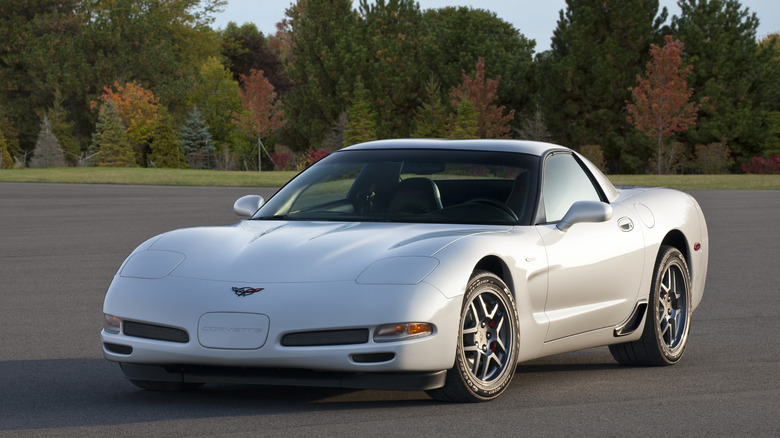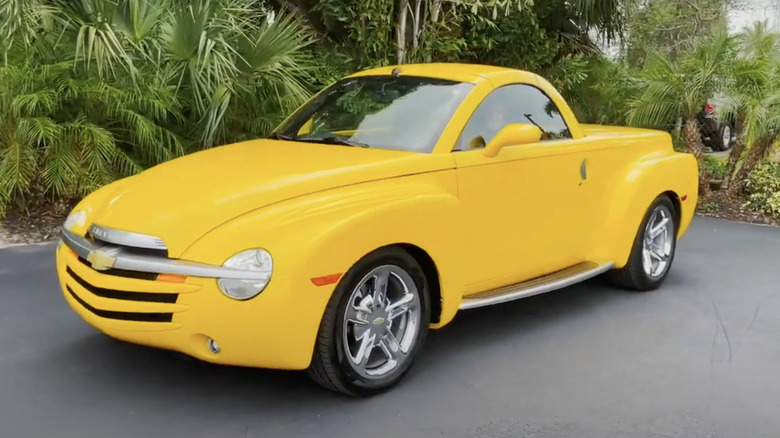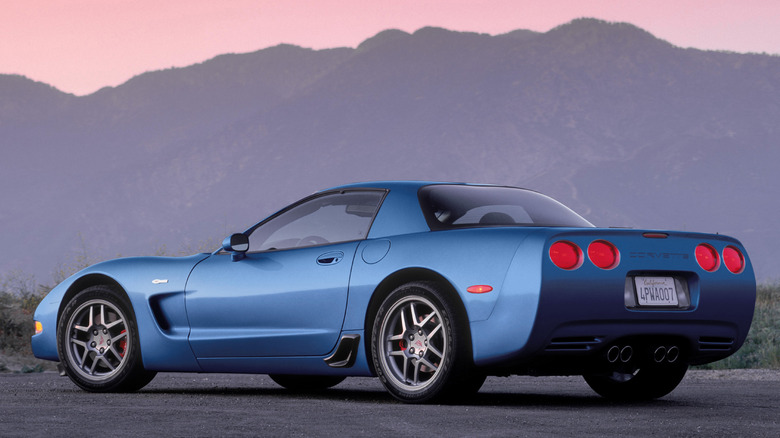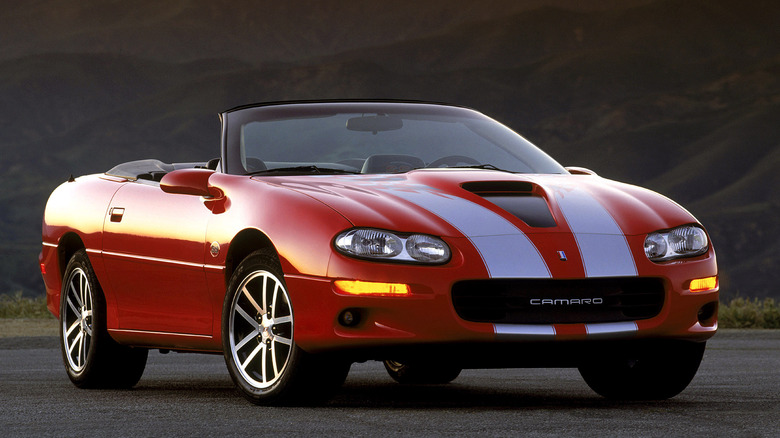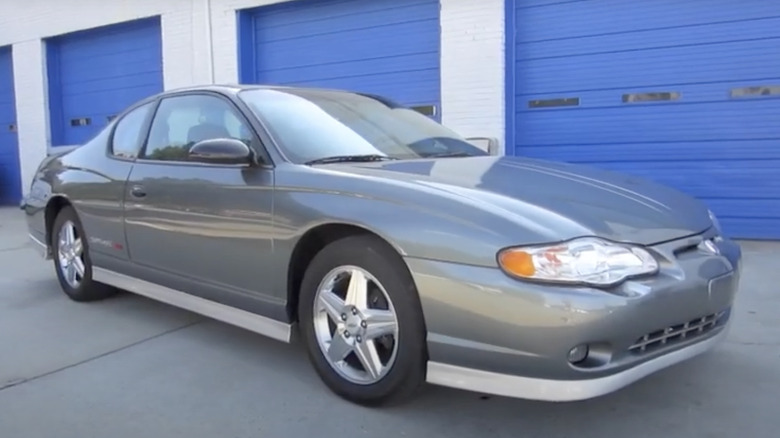4 Chevy Models From The Early 2000s That Are Future Classic Cars
The 1950s and 1960s are seen by many as the best decades for classic cars. American manufacturing brought us all sorts of iconic and beloved vehicles, like the Mustang, GTO, Camaro, Corvette, and many more. These vehicles, and some from the '70s, are celebrated as classics for many reasons, including their styling and power.
How old must a car be to be considered a classic? The answer is subjective, but it's not just old American steel that qualifies. There are lots of vehicles from the 1980s and the 1990s that are considered classics now too. As we inch closer to modern cars, though, it's harder to determine what is and isn't a classic. What will stand the test of time? What's still going to be desirable, and why? Well, there are certainly some contenders from the early 2000s from Chevrolet, offering impressive performance, unique styling, and a bit of built-in nostalgia. Let's take a closer look.
The Chevy SSR was odd but iconic
The Chevrolet SSR is one of the weirdest vehicles to come out of the early 2000s. Technically, it's a pickup truck of sorts. It has a single cab and a bed, neither of which are particularly practical, but they're both there. It's also sort of a sports car, powered by a big V8 and putting that power to the ground via rear-wheel drive. Oh, and to top it all off, it's a convertible. Even before we dig into the power numbers, it's clear that the SSR should be considered unique enough to qualify as a classic.
The first SSR launched in 2003 and was powered by a 5.3-liter V8 paired with a four-speed automatic transmission. The V8 only produced 300 horsepower, and the automatic transmission contributed to its uninspiring driving dynamics, but later models solved those problems in a big way. The SSR eventually got Chevy's 6.0-liter V8, sourced from the Corvette, and paired it with an optional six-speed manual transmission. The 6.0-liter engine put out 390 horsepower and dropped the SSR's 0-60 time from 7.7 seconds down to a much-more-respectable 5.3 seconds.
Some historians and enthusiasts consider the SSR a failure, but that doesn't mean it's not also a classic. Sure, it didn't sell very well, and Chevy had to kill it off after just a few years on the market, but it left its mark — an indelibly strange and singular vehicle in automotive history.
The Corvette C5 Z06 was a beautiful powerhouse
In 1997, Chevrolet redesigned the Corvette, launching the fifth generation of the iconic sports car. The standard version of the C5 Corvette used a 5.7-liter V8 that produced 345 horsepower and 350 lb-ft of torque. The C5 was powerful enough to blast from 0 to 60 mph in just 4.9 seconds, crossing the quarter mile in 13.4 seconds at 108 miles per hour. When it comes to Corvettes, though, the base version is never enough.
In 2001, Chevy took the wraps off the C5 Z06 — an even higher-performance version of the Corvette. Like the standard model, the Z06 was powered by an LS6 V8, but it upped the ante to 385 hp and 385 lb-ft of torque. It went from 0 to 60 mph in just 4.3 seconds, dispensing with the quarter mile in just 12.7 seconds at 113 mph. And, in 2002, power for the Z06 increased to 405 hp and 400 lb-ft of torque, dropping its 0-60 time to just 4.0 seconds and the quarter mile down to 12.4 seconds at 116 mph.
More than just powerful, the Z06 was lighter than the standard model, using a thinner windshield and better exhaust for superior all-around performance. With all its astonishing performance metrics, the C5 Z06 will certainly be considered a classic in the future, if it isn't already.
The fourth-generation Camaro SS ruled the road
Launched in 1993, the fourth-generation Camaro was initially powered by an LT1 V8. The Z28 performance package had more power than the Mustang Cobra of its day, pushing out 275 hp from Chevy's 5.7-liter V8. It was impressive as it stood, but throughout the '90s, the Camaro got several upgrades, and by the early 2000s, it had a lot going for it that would help cement its place in history.
By 2002, the high-performance Camaro SS used the same LS1 V8 that powered the Corvette (an update it received in 1998), putting out 325 hp and 350 lb-ft of torque. Other engines were available, like a standard V6 and a slightly less powerful version of the LS1 for base Z28 models, but the 325-hp SS was the one to have. The inclusion of the Vette's V8 gave the Camaro much more street cred and helped it hold its own against Mustangs of the era that were becoming more powerful as well.
Another hallmark of a classic muscle car, the Camaro was available with a six-speed manual transmission for enthusiasts who love to shift their own gears. The fourth generation of Camaro was officially killed off in 2002, with dwindling sales and reportedly because it couldn't meet new head-impact standards. But before it went the way of the dodo, it had quite the impact on the automotive world.
The Supercharged Monte Carlo SS was underrated
It certainly doesn't have the panache of a Camaro or the performance of a Corvette, but the Monte Carlo SS has an appeal all its own. The sixth-generation Monte Carlo launched in 2000, and it was a bit underwhelming. The Monte Carlo LS used an anemic 3.4-liter V6 that put out just 180 horsepower. The upgraded SS version had a 3.8-liter V6 under the hood produced slightly more (200 hp), and acceleration was pretty sluggish, going from 0-60 mph in 7.3 seconds, but it was definitely more lively.
The most interesting car in the Monte Carlo lineup from that era, however, is the supercharged SS. Launched in 2004, the supercharged SS used the same 3.8-liter V6 but pushed power levels up to 240 hp -– a bit more respectable for the era. Zero to 60 was covered in a less embarrassing 6.5 seconds with the upgraded powertrain, but by 2006, the supercharged engine had been replaced by a 5.3-liter V8, making the supercharged years (2004-2005) automatically more collectable. Much like the SSR, the supercharged V6 front-wheel-drive Monte Carlo is a unique vehicle that only existed for a short period of time. Collectors and enthusiasts will likely appreciate its strangeness, even if nobody else does.
